Junqi Jin
Lightweight Auto-bidding based on Traffic Prediction in Live Advertising
Aug 08, 2025Abstract:Internet live streaming is widely used in online entertainment and e-commerce, where live advertising is an important marketing tool for anchors. An advertising campaign hopes to maximize the effect (such as conversions) under constraints (such as budget and cost-per-click). The mainstream control of campaigns is auto-bidding, where the performance depends on the decision of the bidding algorithm in each request. The most widely used auto-bidding algorithms include Proportional-Integral-Derivative (PID) control, linear programming (LP), reinforcement learning (RL), etc. Existing methods either do not consider the entire time traffic, or have too high computational complexity. In this paper, the live advertising has high requirements for real-time bidding (second-level control) and faces the difficulty of unknown future traffic. Therefore, we propose a lightweight bidding algorithm Binary Constrained Bidding (BiCB), which neatly combines the optimal bidding formula given by mathematical analysis and the statistical method of future traffic estimation, and obtains good approximation to the optimal result through a low complexity solution. In addition, we complement the form of upper and lower bound constraints for traditional auto-bidding modeling and give theoretical analysis of BiCB. Sufficient offline and online experiments prove BiCB's good performance and low engineering cost.
We Know What You Want: An Advertising Strategy Recommender System for Online Advertising
Jun 08, 2021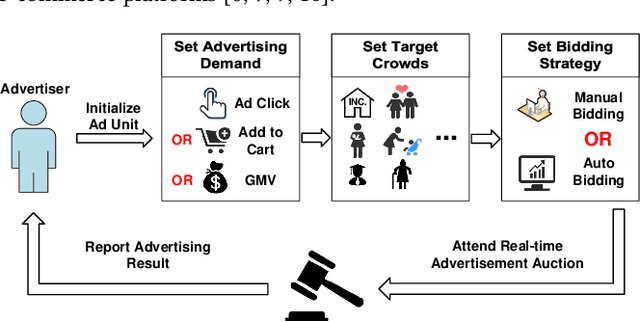
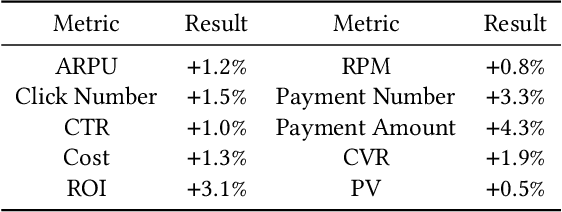
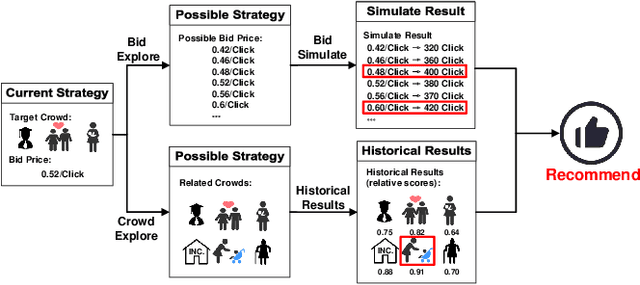

Abstract:Advertising expenditures have become the major source of revenue for e-commerce platforms. Providing good advertising experiences for advertisers through reducing their costs of trial and error for discovering the optimal advertising strategies is crucial for the long-term prosperity of online advertising. To achieve this goal, the advertising platform needs to identify the advertisers' marketing objectives, and then recommend the corresponding strategies to fulfill this objective. In this work, we first deploy a prototype of strategy recommender system on Taobao display advertising platform, recommending bid prices and targeted users to advertisers. We further augment this prototype system by directly revealing the advertising performance, and then infer the advertisers' marketing objectives through their adoptions of different recommending advertising performance. We use the techniques from context bandit to jointly learn the advertisers' marketing objectives and the recommending strategies. Online evaluations show that the designed advertising strategy recommender system can optimize the advertisers' advertising performance and increase the platform's revenue. Simulation experiments based on Taobao online bidding data show that the designed contextual bandit algorithm can effectively optimize the strategy adoption rate of advertisers.
* Accepted by KDD 2021
Learning to Infer User Hidden States for Online Sequential Advertising
Sep 03, 2020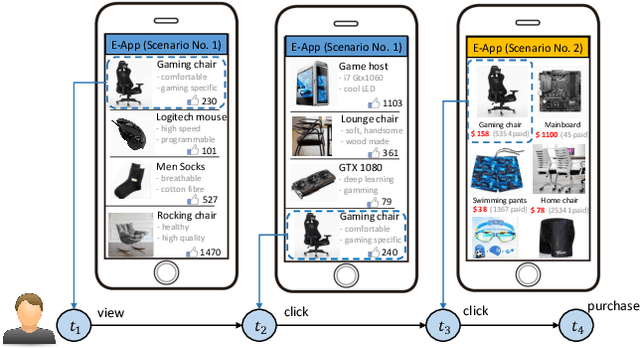
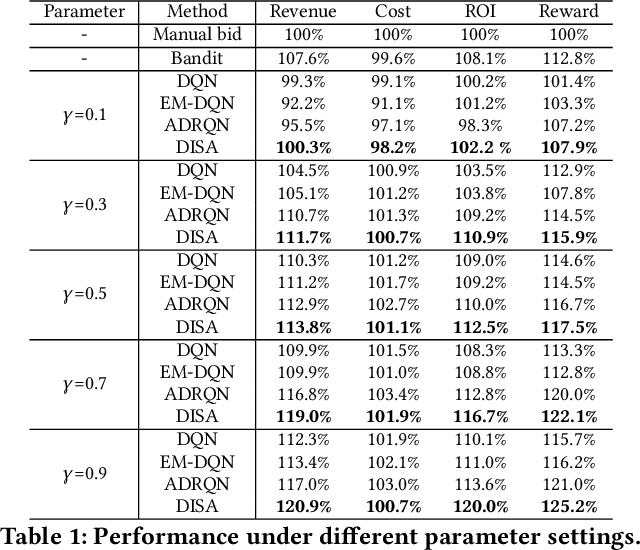
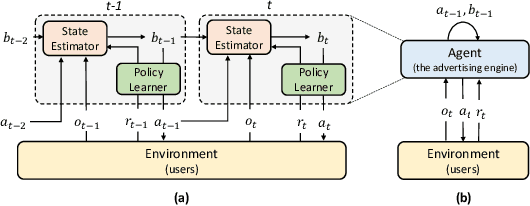

Abstract:To drive purchase in online advertising, it is of the advertiser's great interest to optimize the sequential advertising strategy whose performance and interpretability are both important. The lack of interpretability in existing deep reinforcement learning methods makes it not easy to understand, diagnose and further optimize the strategy. In this paper, we propose our Deep Intents Sequential Advertising (DISA) method to address these issues. The key part of interpretability is to understand a consumer's purchase intent which is, however, unobservable (called hidden states). In this paper, we model this intention as a latent variable and formulate the problem as a Partially Observable Markov Decision Process (POMDP) where the underlying intents are inferred based on the observable behaviors. Large-scale industrial offline and online experiments demonstrate our method's superior performance over several baselines. The inferred hidden states are analyzed, and the results prove the rationality of our inference.
A Deep Prediction Network for Understanding Advertiser Intent and Satisfaction
Aug 20, 2020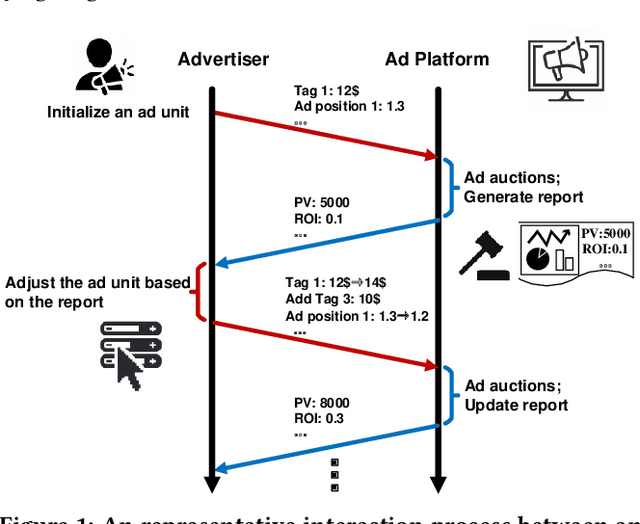

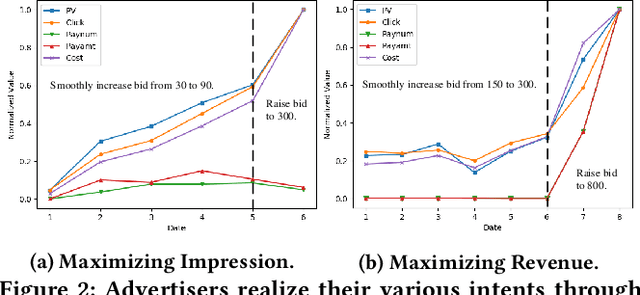
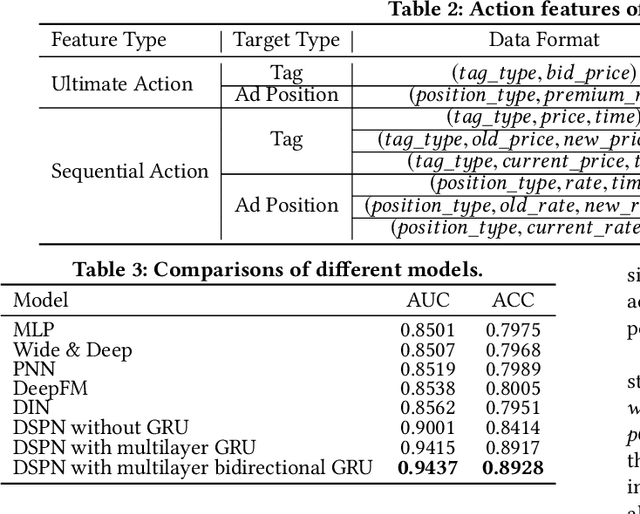
Abstract:For e-commerce platforms such as Taobao and Amazon, advertisers play an important role in the entire digital ecosystem: their behaviors explicitly influence users' browsing and shopping experience; more importantly, advertiser's expenditure on advertising constitutes a primary source of platform revenue. Therefore, providing better services for advertisers is essential for the long-term prosperity for e-commerce platforms. To achieve this goal, the ad platform needs to have an in-depth understanding of advertisers in terms of both their marketing intents and satisfaction over the advertising performance, based on which further optimization could be carried out to service the advertisers in the correct direction. In this paper, we propose a novel Deep Satisfaction Prediction Network (DSPN), which models advertiser intent and satisfaction simultaneously. It employs a two-stage network structure where advertiser intent vector and satisfaction are jointly learned by considering the features of advertiser's action information and advertising performance indicators. Experiments on an Alibaba advertisement dataset and online evaluations show that our proposed DSPN outperforms state-of-the-art baselines and has stable performance in terms of AUC in the online environment. Further analyses show that DSPN not only predicts advertisers' satisfaction accurately but also learns an explainable advertiser intent, revealing the opportunities to optimize the advertising performance further.
Dynamic Knapsack Optimization Towards Efficient Multi-Channel Sequential Advertising
Jun 29, 2020
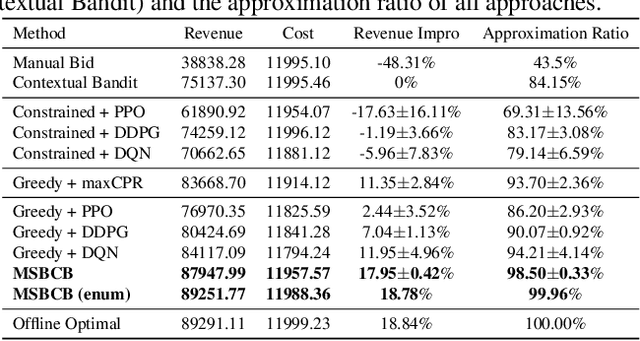
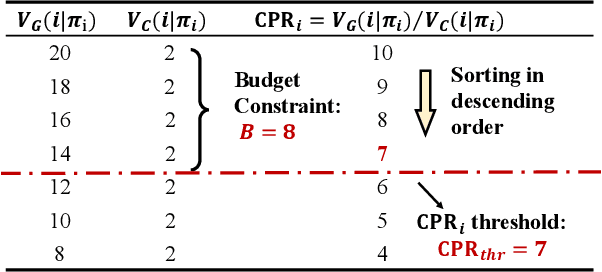

Abstract:In E-commerce, advertising is essential for merchants to reach their target users. The typical objective is to maximize the advertiser's cumulative revenue over a period of time under a budget constraint. In real applications, an advertisement (ad) usually needs to be exposed to the same user multiple times until the user finally contributes revenue (e.g., places an order). However, existing advertising systems mainly focus on the immediate revenue with single ad exposures, ignoring the contribution of each exposure to the final conversion, thus usually falls into suboptimal solutions. In this paper, we formulate the sequential advertising strategy optimization as a dynamic knapsack problem. We propose a theoretically guaranteed bilevel optimization framework, which significantly reduces the solution space of the original optimization space while ensuring the solution quality. To improve the exploration efficiency of reinforcement learning, we also devise an effective action space reduction approach. Extensive offline and online experiments show the superior performance of our approaches over state-of-the-art baselines in terms of cumulative revenue.
Learning to Accelerate Heuristic Searching for Large-Scale Maximum Weighted b-Matching Problems in Online Advertising
May 12, 2020



Abstract:Bipartite b-matching is fundamental in algorithm design, and has been widely applied into economic markets, labor markets, etc. These practical problems usually exhibit two distinct features: large-scale and dynamic, which requires the matching algorithm to be repeatedly executed at regular intervals. However, existing exact and approximate algorithms usually fail in such settings due to either requiring intolerable running time or too much computation resource. To address this issue, we propose \texttt{NeuSearcher} which leverages the knowledge learned from previously instances to solve new problem instances. Specifically, we design a multichannel graph neural network to predict the threshold of the matched edges weights, by which the search region could be significantly reduced. We further propose a parallel heuristic search algorithm to iteratively improve the solution quality until convergence. Experiments on both open and industrial datasets demonstrate that \texttt{NeuSearcher} can speed up 2 to 3 times while achieving exactly the same matching solution compared with the state-of-the-art approximation approaches.
Learning to Advertise for Organic Traffic Maximization in E-Commerce Product Feeds
Aug 19, 2019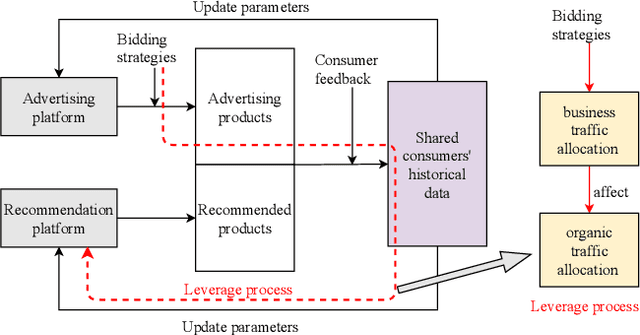
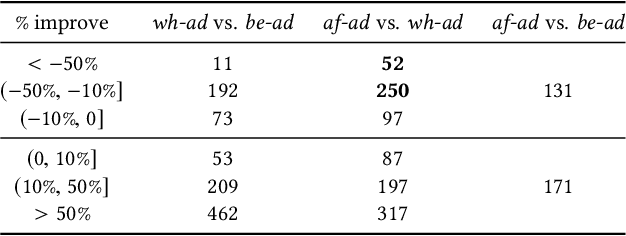
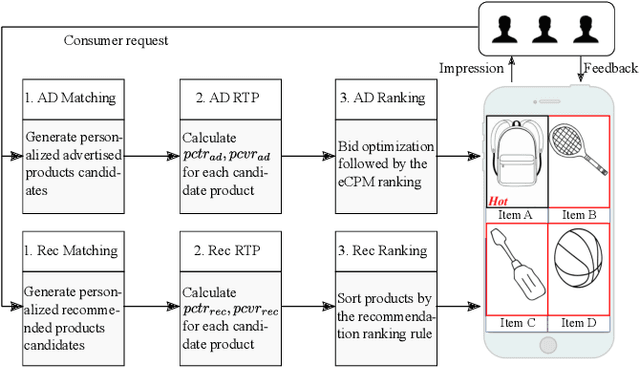
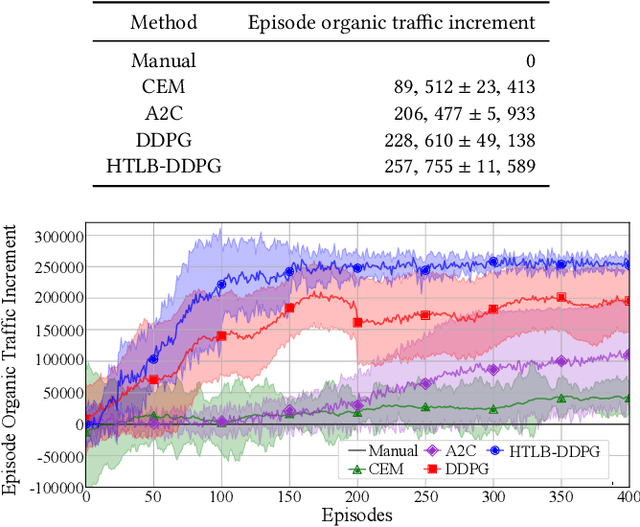
Abstract:Most e-commerce product feeds provide blended results of advertised products and recommended products to consumers. The underlying advertising and recommendation platforms share similar if not exactly the same set of candidate products. Consumers' behaviors on the advertised results constitute part of the recommendation model's training data and therefore can influence the recommended results. We refer to this process as Leverage. Considering this mechanism, we propose a novel perspective that advertisers can strategically bid through the advertising platform to optimize their recommended organic traffic. By analyzing the real-world data, we first explain the principles of Leverage mechanism, i.e., the dynamic models of Leverage. Then we introduce a novel Leverage optimization problem and formulate it with a Markov Decision Process. To deal with the sample complexity challenge in model-free reinforcement learning, we propose a novel Hybrid Training Leverage Bidding (HTLB) algorithm which combines the real-world samples and the emulator-generated samples to boost the learning speed and stability. Our offline experiments as well as the results from the online deployment demonstrate the superior performance of our approach.
Spectral-based Graph Convolutional Network for Directed Graphs
Jul 21, 2019



Abstract:Graph convolutional networks(GCNs) have become the most popular approaches for graph data in these days because of their powerful ability to extract features from graph. GCNs approaches are divided into two categories, spectral-based and spatial-based. As the earliest convolutional networks for graph data, spectral-based GCNs have achieved impressive results in many graph related analytics tasks. However, spectral-based models cannot directly work on directed graphs. In this paper, we propose an improved spectral-based GCN for the directed graph by leveraging redefined Laplacians to improve its propagation model. Our approach can work directly on directed graph data in semi-supervised nodes classification tasks. Experiments on a number of directed graph datasets demonstrate that our approach outperforms the state-of-the-art methods.
Optimized Cost per Click in Taobao Display Advertising
Nov 01, 2018



Abstract:Taobao, as the largest online retail platform in the world, provides billions of online display advertising impressions for millions of advertisers every day. For commercial purposes, the advertisers bid for specific spots and target crowds to compete for business traffic. The platform chooses the most suitable ads to display in tens of milliseconds. Common pricing methods include cost per mille (CPM) and cost per click (CPC). Traditional advertising systems target certain traits of users and ad placements with fixed bids, essentially regarded as coarse-grained matching of bid and traffic quality. However, the fixed bids set by the advertisers competing for different quality requests cannot fully optimize the advertisers' key requirements. Moreover, the platform has to be responsible for the business revenue and user experience. Thus, we proposed a bid optimizing strategy called optimized cost per click (OCPC) which automatically adjusts the bid to achieve finer matching of bid and traffic quality of page view (PV) request granularity. Our approach optimizes advertisers' demands, platform business revenue and user experience and as a whole improves traffic allocation efficiency. We have validated our approach in Taobao display advertising system in production. The online A/B test shows our algorithm yields substantially better results than previous fixed bid manner.
Deep Interest Network for Click-Through Rate Prediction
Sep 13, 2018



Abstract:Click-through rate prediction is an essential task in industrial applications, such as online advertising. Recently deep learning based models have been proposed, which follow a similar Embedding\&MLP paradigm. In these methods large scale sparse input features are first mapped into low dimensional embedding vectors, and then transformed into fixed-length vectors in a group-wise manner, finally concatenated together to fed into a multilayer perceptron (MLP) to learn the nonlinear relations among features. In this way, user features are compressed into a fixed-length representation vector, in regardless of what candidate ads are. The use of fixed-length vector will be a bottleneck, which brings difficulty for Embedding\&MLP methods to capture user's diverse interests effectively from rich historical behaviors. In this paper, we propose a novel model: Deep Interest Network (DIN) which tackles this challenge by designing a local activation unit to adaptively learn the representation of user interests from historical behaviors with respect to a certain ad. This representation vector varies over different ads, improving the expressive ability of model greatly. Besides, we develop two techniques: mini-batch aware regularization and data adaptive activation function which can help training industrial deep networks with hundreds of millions of parameters. Experiments on two public datasets as well as an Alibaba real production dataset with over 2 billion samples demonstrate the effectiveness of proposed approaches, which achieve superior performance compared with state-of-the-art methods. DIN now has been successfully deployed in the online display advertising system in Alibaba, serving the main traffic.
 Add to Chrome
Add to Chrome Add to Firefox
Add to Firefox Add to Edge
Add to Edge